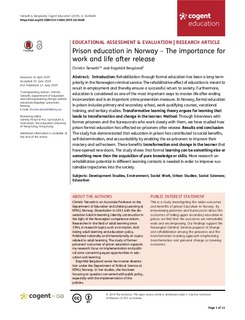| dc.contributor.author | Tønseth, Christin | |
| dc.contributor.author | Bergsland, Ragnhild | |
| dc.date.accessioned | 2019-09-25T06:28:14Z | |
| dc.date.available | 2019-09-25T06:28:14Z | |
| dc.date.created | 2019-06-07T13:03:30Z | |
| dc.date.issued | 2019 | |
| dc.identifier.citation | Cogent Education. 2019, 6 | nb_NO |
| dc.identifier.issn | 2331-186X | |
| dc.identifier.uri | http://hdl.handle.net/11250/2618599 | |
| dc.description.abstract | Introduction: Rehabilitation through formal education has been a long-term priority in the Norwegian criminal service. The rehabilitative effect of education is meant to result in employment and thereby ensure a successful return to society. Furthermore, education is considered as one of the most important ways to master life after ending incarceration and is an important crime prevention measure. In Norway, formal education in prison includes primary and secondary school, work qualifying courses, vocational training, and tertiary studies. Transformative learning theory argues for learning that leads to transformation and change in the learner. Method: Through Interviews with former prisoners and the bureaucrats who work closely with them, we have studied how prison formal education has affected ex-prisoners after release. Results and conclusion: The study has demonstrated that education in prison has contributed to social benefits, self-determination, and accountability by enabling the ex-prisoners to improve their mastery and self-esteem. These benefits transformation and change in the learner that have opened new doors. The study shows that formal learning can be something else or something more than the acquisition of pure knowledge or skills. More research on rehabilitation potential in different learning contexts is needed in order to improve sustainable trajectories into the society. | nb_NO |
| dc.language.iso | eng | nb_NO |
| dc.publisher | Cogent OA, part of the Taylor & Francis Group | nb_NO |
| dc.rights | Navngivelse 4.0 Internasjonal | * |
| dc.rights.uri | http://creativecommons.org/licenses/by/4.0/deed.no | * |
| dc.title | Prison Education in Norway – the importance for work and life after release | nb_NO |
| dc.type | Journal article | nb_NO |
| dc.type | Peer reviewed | nb_NO |
| dc.description.version | publishedVersion | nb_NO |
| dc.source.volume | 6 | nb_NO |
| dc.source.journal | Cogent Education | nb_NO |
| dc.identifier.doi | 10.1080/2331186X.2019.1628408 | |
| dc.identifier.cristin | 1703473 | |
| dc.description.localcode | © 2019 The Author(s). This open access article is distributed under a Creative Commons Attribution (CC-BY) 4.0 license. | nb_NO |
| cristin.unitcode | 194,67,70,0 | |
| cristin.unitcode | 194,67,25,0 | |
| cristin.unitname | Institutt for pedagogikk og livslang læring | |
| cristin.unitname | Institutt for sosiologi og statsvitenskap | |
| cristin.ispublished | true | |
| cristin.fulltext | original | |
| cristin.qualitycode | 1 | |

